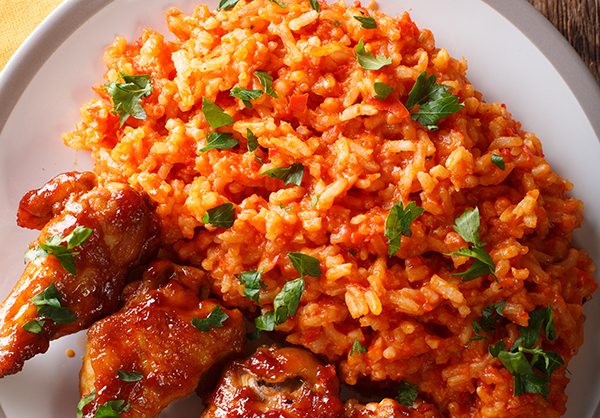News Release
JOLLOF RICE
March 1, 2022
March 1, 2022
JOLLOF RICE

Jollof rice, a mouth-watering spicy delicacy, is one of the world's greatest rice dishes. It was originally from Senegal but has spread to other West Africa countries including Nigeria, Ghana, Sierra Leone, Liberia, Cameroon and Gambia.
It is basically made by cooking white rice mixed in a savory and spicy tomato based sauce- which gives jollof rice its typical deep-red appearance. Almost every West African country has its own version of this world famous dish. These variations are possibly based on how the ingredients were combined during cooking or the inclusion of optional ingredients which differs from country to country. The unique combination of spices makes jollof rice have a mesmerizing aroma which welcomes you when approaching the reception at parties or restaurants.
Jollof rice is very close to the heart and soul of West Africans that there exist a friendly dispute between different West African countries over which country makes "the truest and the best jollof rice". Particularly, this friendly jollof war has existed between Nigeria and Ghana for decades and has travelled beyond the shores of Africa! For example, it attracted the special interest of renowned Richard Quest of CNN during his visit to Nigeria few years ago. Jollof rice is no doubt the queen of West African cuisine relished with passion and so much pride. It is no surprise then that several academic researchers have published many scholarly and scientific articles bordering on the quality, chemistry and economics of the dish.
Another factor that gives a Jollof rice dish its uniqueness is the type or cultivar of rice used which again varies depending on the region. For example, most people in Nigeria prefer to use the partially boiled Parboiled long grain rice while Ghanaians may prefer the aromatic rice, Basmati.
Ironically, most of the rice, main component of the West African jollof rice, used to be imported from Asia. The major reason for this choice is because many locals think that the imported rice is better than locally grown rice. However, a closer look into the matter revealed that this perception stems from concerns that the locally grown rice contain contaminants such as stones, debris and other foreign materials- a result of poor postharvest handling of rice, as well as poor milling and sorting.

We at Satake have thus stood up to this challenge because we believe that no locally grown rice in West Africa is inferior, rather, high quality rice processing equipment is required to handle rice and produce high quality rice for human consumption. During the past few years, we have adapted our time-proven rice milling technology to provide many customers in Africa with solutions to meet the ever growing local rice needs. We are happy and proud that our customers in the region have since been enjoying Satake's highly performing rice processing equipment, as well as the products contributing to vitalization of the rice cultivation and thus further enrich the food culture. Check out our rice milling solution- REACH, here. |REACH- Best Solution in Rice Processing (satake-reach.com)
